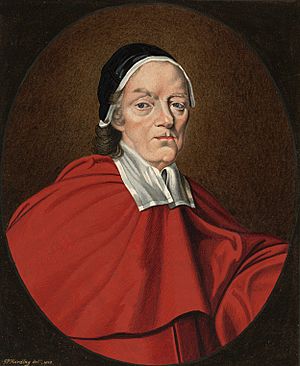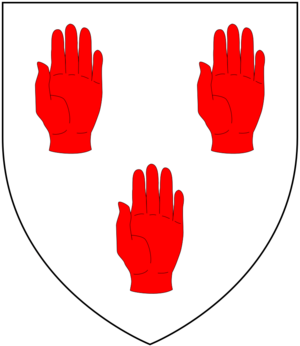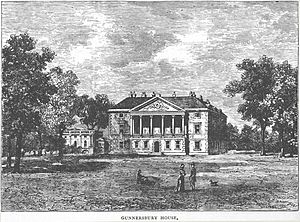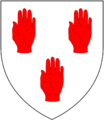John Maynard (1604–1690) facts for kids
Quick facts for kids
Sir John Maynard
|
|
|---|---|

Maynard's portrait.
|
|
| Born | 1604 prob. Tavistock
|
| Died | 1690 Gunnersbury Park
|
| Resting place | Ealing Church |
| Nationality | English |
| Education | Exeter College, Oxford |
| Occupation | lawyer and politician |
| Known for | Revising the Year Books |
| Spouse(s) |
|
| Children | one son and four daughters |
| Parent(s) | Alexander and Honora Maynard |
Sir John Maynard (1604 – 9 October 1690) was an important English lawyer and politician. He served under several English rulers, including King Charles I, during the time England was a Commonwealth (without a king), and under King Charles II, King James II, and King William III.
Contents
Early Life and School
Maynard was born in 1604 in Tavistock, Devon. He was the oldest son of Alexander Maynard, who was also a lawyer. His family had lived in Sherford, Devon, for a long time.
John Maynard went to Exeter College, Oxford, a famous university. He earned his first degree there in 1621.
Becoming a Lawyer
In 1619, John Maynard joined the Middle Temple, one of the places where lawyers are trained in London. He became a lawyer in 1626. He quickly became very successful, working on many cases across England and in London.
In 1640, he became the Recorder of Plymouth. This meant he was a judge who helped lead the local court.
Working in Parliament
Maynard was elected to represent Totnes in Parliament in 1640. He quickly became very active in government. He helped investigate how local leaders were doing their jobs. He also helped write the charges against Lord Strafford, a powerful figure, who was later put on trial.
Maynard was a strong Presbyterian, a type of Protestant Christian. He signed a promise in 1641 to defend the Protestant religion. He also helped create a law that made this promise required for everyone.
When King Charles I tried to arrest five members of Parliament, Maynard spoke strongly in defense of Parliament's rights. In 1643, he joined the Westminster Assembly of Divines, a group of religious leaders and politicians. He also helped with the trial of William Laud, the Archbishop of Canterbury.
Maynard was known for being a strict supporter of the English constitution. He disagreed with the steps taken to remove the King. Because of this, he left Parliament in 1648, believing it was no longer a lawful assembly.
Legal Work During the Commonwealth
Even though he disagreed with the King's removal, Maynard continued his legal work when England became a Commonwealth (a republic without a king). He became a senior lawyer, called a serjeant-at-law, in 1654.
In 1655, Maynard and two other lawyers were briefly sent to the Tower of London. This happened because they argued in court against the government's right to collect certain taxes. They were released after they agreed to follow the rules.
Continuing in Politics
Maynard continued to be an important political figure. He was a Member of Parliament for Plymouth and later for Newtown. He supported bringing back the old name for the House of Lords. He also likely supported bringing back the monarchy.
When Richard Cromwell became the new leader after his father Oliver Cromwell died, Maynard was made the Solicitor General. This meant he was a top legal advisor to the government. He used his legal knowledge to try and support Richard Cromwell's government.
Helping Found Schools
In 1658, Maynard helped start two schools in Exeter: The Maynard School for girls and Hele's School for boys. He also helped the Grammar school in Totnes. These schools were funded by money left by Elize Hele for charity. Maynard was one of the people in charge of making sure the money was used correctly.
The King Returns
When the monarchy was brought back to England in 1660, Maynard quickly became a King's Serjeant. This was a very high legal position. He was also knighted, becoming "Sir John Maynard." He even rode in the coronation parade for King Charles II in 1661.
Under King Charles II
As King's Serjeant, Maynard worked on many important state trials. He represented the Crown in some cases. He also served as a Member of Parliament for Bere Alston and Plymouth during King Charles II's reign.
Maynard was involved in the trial of Lord Mordaunt and defended Lord Clarendon in his legal proceedings. He also took part in many trials related to the "Popish Plot," a time when many people feared a Catholic conspiracy against the King.
Maynard was known for his careful approach to constitutional issues. He tried to balance the King's powers with the rights of Parliament.
Under King James II
During the reign of King James II, Maynard continued to be a Member of Parliament for Bere Alston. He spoke out against parts of a bill that would make it treason to say that the Duke of Monmouth was a rightful heir. He also opposed the King's request for more money to create a standing army.
In 1688, when King James II fled, Maynard was called to a meeting of important lords to discuss the situation. When William of Orange arrived in London to take the throne, Maynard, as the oldest lawyer, was introduced to him. William congratulated Maynard on living longer than so many rivals. Maynard famously replied, "And I had like to have outlived the law itself had not your highness come over."
Under King William III
Maynard continued to serve in Parliament for Plymouth. He argued that King James II had given up the throne by his actions and that a new ruler was needed.
In March 1689, he became one of the Lord Commissioners of the Great Seal, a very high legal office. He continued to be active in Parliament, even proposing a bill to disarm Catholics. He retired from this office in May 1690.
His Reputation
Even though he was very old when he held his highest judicial office, Maynard was highly respected. People called him "the best old book lawyer of his time." He was known for his "great learning" and "knowledge in the more profound and perplexed parts of the law."
Maynard was seen as moderate and consistent in his politics. He was a skilled speaker, even if not always eloquent. He was known for his sharp comebacks. Once, when a judge named Jeffreys said Maynard had forgotten his law, Maynard replied, "In that case I must have forgotten a great deal more than your lordship ever knew."
Maynard also helped publish an important collection of old legal reports called the Year Books of Edward II.
Gunnersbury Park
Sir John Maynard became very wealthy. He bought the land of Gunnersbury and, in 1663, built a grand house there called Gunnersbury House. This house later became the home of Princess Amelia of the United Kingdom, the daughter of King George II.
Maynard died at Gunnersbury House on 9 October 1690. He was buried with a large ceremony in Ealing Church.
Family Life
Maynard was married four times. His first wife was Elizabeth Henley, with whom he had one son and four daughters. Elizabeth was buried in Ealing Church in 1655. His second wife was Jane Austen, who died in 1668. His third wife was Margaret Gorges. His fourth wife was Mary Upton, who outlived him and remarried.
Maynard outlived all his children except his youngest daughter. He left his property to his granddaughters. His will was so complicated that a special act of Parliament was needed to sort out the disputes over it.
You can see portraits of Sir John Maynard in the National Portrait Gallery and at Exeter College, Oxford.
Images for kids






